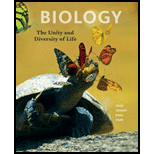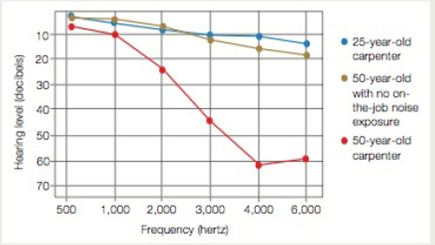
Concept explainers
Occupational Hearing Loss Frequent exposure to loud noise of a particular pitch can cause loss of hair cells in the part of the cochlea that responds to that pitch. People who work with or around noisy machinery are at risk for such frequency-specific hearing loss. Taking precautions such as using ear plugs to reduce sound exposure is important. Noise-induced hearing loss can be prevented, but once it occurs it is irreversible because dead or damaged hair cells are not replaced.
FIGURE 33.24 shows the threshold decibel levels at which sounds of different frequencies can be detected by an average 25-year-old carpenter, a 50-year-old carpenter, and a 50-year-old who has not been exposed to on-the-job noise. Sound frequencies are given in hertz (cycles per second). The more cycles per second, the higher the pitch.

FIGURE 33.24 Effects of age aria occupational noise exposure. The graph shows the threshold hearing capacities fin decibels) for sounds of different frequencies (given in hertz) in a 25-year-okj carpenter (blue), a 50-year-old carpenter (red), and a 50-year-otd who did not have any on-the-job noise exposure (brown).
3. Which of the three people had the best hearing in the range of 4,000 to 6,000 hertz? Which had the worst?
Trending nowThis is a popular solution!

Chapter 33 Solutions
Biology: The Unity and Diversity of Life (MindTap Course List)
- Occupational Hearing Loss Frequent exposure to loud noise of a particular pitch can cause loss of hair cells in the part of the cochlea that responds to that pitch. People who work with or around noisy machinery are at risk for such frequency-specific hearing loss. Taking precautions such as using ear plugs to reduce sound exposure is important. Noise-induced hearing loss can be prevented, but once it occurs it is irreversible because dead or damaged hair cells are not replaced. FIGURE 33.24 shows the threshold decibel levels at which sounds of different frequencies can be detected by an average 25-year-old carpenter, a 50-year-old carpenter, and a 50-year-old who has not been exposed to on-the-job noise. Sound frequencies are given in hertz (cycles per second). The more cycles per second, the higher the pitch. FIGURE 33.24 Effects of age aria occupational noise exposure. The graph shows the threshold hearing capacities fin decibels) for sounds of different frequencies (given in hertz) in a 25-year-okj carpenter (blue), a 50-year-old carpenter (red), and a 50-year-otd who did not have any on-the-job noise exposure (brown). 4. Based on these data, would you conclude that the hearing decline in the 50-year-old carpenter was caused by age or by job-related noise exposure?arrow_forwardOccupational Hearing Loss Frequent exposure to loud noise of a particular pitch can cause loss of hair cells in the part of the cochlea that responds to that pitch. People who work with or around noisy machinery are at risk for such frequency-specific hearing loss. Taking precautions such as using ear plugs to reduce sound exposure is important. Noise-induced hearing loss can be prevented, but once it occurs it is irreversible because dead or damaged hair cells are not replaced. FIGURE 33.24 shows the threshold decibel levels at which sounds of different frequencies can be detected by an average 25-year-old carpenter, a 50-year-old carpenter, and a 50-year-old who has not been exposed to on-the-job noise. Sound frequencies are given in hertz (cycles per second). The more cycles per second, the higher the pitch. FIGURE 33.24 Effects of age aria occupational noise exposure. The graph shows the threshold hearing capacities fin decibels) for sounds of different frequencies (given in hertz) in a 25-year-okj carpenter (blue), a 50-year-old carpenter (red), and a 50-year-otd who did not have any on-the-job noise exposure (brown). 2. How loud did a 1,000-hertz sound have to be for the 50-year-old carpenter to detect it?arrow_forwardFigure 36.14 Cochlear implants can restore hearing in people who have a nonfunctional cochlea The implant consists of a microphone that picks up sound. A speech processor selects sounds in the range of human speech, and a transmitter converts these sounds to electrical impulses, which are then sent to the auditory nerve. Which of the following types of hearing loss would not be restored by a cochlear implant? Hearing loss resulting from absence or loss of hair cells in the organ of Corti. Hearing loss resulting from an abnormal auditory nerve. Hearing loss resulting from fracture of the cochlea. Hearing loss resulting from damage to bones of the middle ear.arrow_forward
- Match each of the following terms with the appropriate description. _____ somatic senses (general senses)a.produced by strong stimulation _____ special sensesb.endings of sensory neurons or specialized cells next to them _____ variations in stimulus intensity _____ action potentialc.taste, smell, hearing, balance, and vision _____ sensory receptord.frequency and number of action potentials e.touch, pressure, temperature, pain, and muscle sensearrow_forwardFigure 14.9 The basilar membrane is the thin membrane that extends from the central core of the cochlea to the edge. What is anchored to this membrane so that they can be activated by movement of the fluids within the cochlea? Figure 14.9 Cochlea and Organ of Corti LM × 412. (Micrograph provided by the Regents of University of Michigan Medical School © 2012)arrow_forwardJill is diagnosed with sensorineural deafness, a disorder in which sound waves are transmitted normally to the inner ear but they are not translated into neural signals that travel to the brain. Sometimes the cause is a problem with the auditory nerve, but in Jills case it has to do with a problem in the inner ear itself. Where in the inner ear is the disruption most likely to be located?arrow_forward
- SCIENCE, TECHNOLOGY, AND SOCIETY Cochlear implants bring hearing to many children who are born deaf. The prognosis is best when the device is implanted before the child is three years old (during the early years when language is developed). Many individuals in the deaf community (which consists of individuals born deaf or who are affected by deafness) who communicate with sign language oppose cochlear implants. They do not view the inability to hear as a disability. This perspective raises ethical questions for some families with children who are deaf. Argue for and against cochlear implants for very young children.arrow_forwardSituation: Noise at Work Ediberto is 18 years old, and has been working for a company that manufactures prefabricated homes for about a year. He spends a lot of the work day using a power saw. His ears usually ring for a while in the evening, but it seems to clear up by the morning. He is a little worried about whether it’s damaging his hearing, but it’s not that different than how his ears feel after a rock concert. He wants to find some information on how much noise is bad for you, and what he can do. Questions for following story. 1. What went right in this situation? 2. What went wrong in this situation? 3. What steps should be taken in this workplace to make sure employees are better protected and prepared the next time?arrow_forwardPut the following parts of the ear in the order in which sounds waves would pass through them: auditory canal, cochlea, cochlear branch of vestibulocochlear nerve, incus, malleus, oval window, stapes, tympanic membranearrow_forward
- Discuss the somewhat surprising outcome of research on hearing loss in urban versus rural environments, and the physiological explanation behind it. Please include references.arrow_forwardHearing Ear Model Label the following structures on this diagram of the ear: external ear: auricle external acoustic meatus middle ear: tympanic membrane malleus incus internal ear: oval window cochlea semicircular canals bone CN VIII: vestibular branch cochlear branch auditory tube stapes round window temporal Now locate the EAR MODEL and identify these same structures.arrow_forwardCochlear implants are devices that can be used to restore hearing in some individuals. The implant stimulates the cochlearnerve through electrical impulses. Why are cochlear implants not ideal for all types of hearing loss?arrow_forward
 Biology: The Unity and Diversity of Life (MindTap...BiologyISBN:9781305073951Author:Cecie Starr, Ralph Taggart, Christine Evers, Lisa StarrPublisher:Cengage Learning
Biology: The Unity and Diversity of Life (MindTap...BiologyISBN:9781305073951Author:Cecie Starr, Ralph Taggart, Christine Evers, Lisa StarrPublisher:Cengage Learning Biology 2eBiologyISBN:9781947172517Author:Matthew Douglas, Jung Choi, Mary Ann ClarkPublisher:OpenStax
Biology 2eBiologyISBN:9781947172517Author:Matthew Douglas, Jung Choi, Mary Ann ClarkPublisher:OpenStax Human Physiology: From Cells to Systems (MindTap ...BiologyISBN:9781285866932Author:Lauralee SherwoodPublisher:Cengage Learning
Human Physiology: From Cells to Systems (MindTap ...BiologyISBN:9781285866932Author:Lauralee SherwoodPublisher:Cengage Learning Human Biology (MindTap Course List)BiologyISBN:9781305112100Author:Cecie Starr, Beverly McMillanPublisher:Cengage Learning
Human Biology (MindTap Course List)BiologyISBN:9781305112100Author:Cecie Starr, Beverly McMillanPublisher:Cengage Learning Biology (MindTap Course List)BiologyISBN:9781337392938Author:Eldra Solomon, Charles Martin, Diana W. Martin, Linda R. BergPublisher:Cengage Learning
Biology (MindTap Course List)BiologyISBN:9781337392938Author:Eldra Solomon, Charles Martin, Diana W. Martin, Linda R. BergPublisher:Cengage Learning Biology: The Dynamic Science (MindTap Course List)BiologyISBN:9781305389892Author:Peter J. Russell, Paul E. Hertz, Beverly McMillanPublisher:Cengage Learning
Biology: The Dynamic Science (MindTap Course List)BiologyISBN:9781305389892Author:Peter J. Russell, Paul E. Hertz, Beverly McMillanPublisher:Cengage Learning





